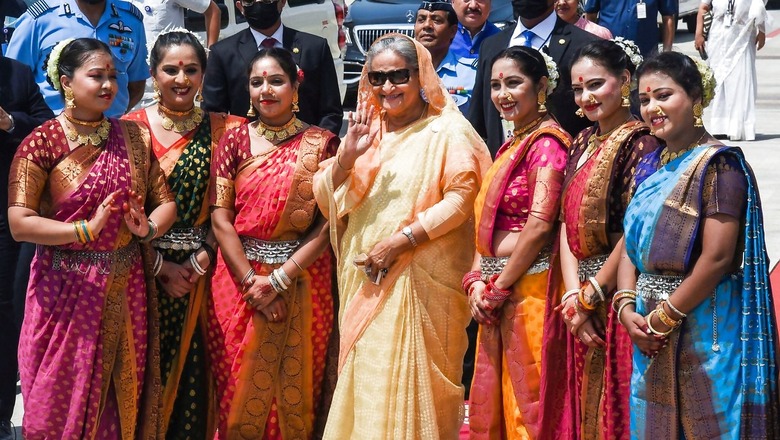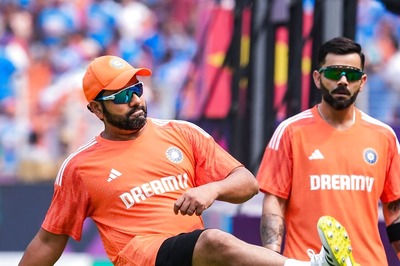
views
As the red carpet is laid out in the Rashtrapati Bhawan to welcome Sheikh Hasina today, time is ripe for India to express its gratitude to her for bringing Bangladesh closer to India.
Sheikh Hasina’s visit to India on September 5 could be her last in this term as the prime minister of Bangladesh. Indeed, it may well be the time for India to express its gratitude to her. It was, after all, during the last over two decades of her rule that Islamists and war criminals in Bangladesh that were not only threatening the secular identity of Bangladesh but were rabidly anti-India were acted against.
Hasina also skilfully led the crackdown on Indian terrorists that were billeting in Bangladesh. She undertook the task despite the reluctance — and even resistance — that continues to characterise an important section of the Bangladesh Army and the Directorate General of Forces Intelligence.
The old tie network that had endeared the Army and the intelligence of Bangladesh with Pakistan and ones that had been inherited from the “Islamist backed barrack politics” system that was governing the erstwhile East Pakistan for several decades was at best ambivalent. The direction of affinity of some of the senior intelligence officers that this author met in Bangladesh during his visit to the erstwhile East Pakistan in 2016 and who were alumni of Pakistani institutions such as the Command and Staff College, Quetta were apparent.
In any event, one of the successes of Sheikh Hasina’s campaign against the 1971 war criminals were the hanging of several Rajakars, including Salahuddin Quader Choudhury, Abdul Quader Mollah and Motiur Rahman Nizami, who had not only aided the Pakistan Army in its pogroms during the pre-liberation days, but had also committed atrocities against the Hindu population of Bangladesh.
If history is to be briefly resurrected, Choudhury was responsible for — among other crimes — the massacre of an entire village of Hindus in Patia on June 16, 1971, and Mollah of killing 344 people and raping of an 11-year-old girl. The popular outrage against the war criminals was so pronounced that a protest was engineered in Dhaka’s Shahbag Square in February 2013 which called for altering the sentence of life imprisonment to execution for Mollah and for the banning of the Jamaat-e-Islami.
However, despite the fact that the word “genocide” is used by scholars to describe the events that led up to the 1971 war, the allegation that a genocide actually took place during the Bangladesh war of 1971 was never probed by an international tribunal. This was primarily due to the partisan role of the United States at the time, which was clearly not in favour of the severance of Pakistan.
Pakistan’s role both in the genocide and its continuing subterfuges against India inside Bangladesh is a proven fact. However, the primary concern of the present pertains to the anti-India role that China is playing in Bangladesh. This is so notwithstanding the “balancing act” that Hasina has been able to conjure up between the two Asian giants.
One aspect of Bangladesh’s socio-cultural polity that is generally not understood is the schism that continues to characterise the secular Bangladeshi who is secured to the concerns of Bengali linguistic nationalism and the one who identifies oneself with the religious overtones of Pakistani irredentism, and even with radical Salafism that has caught the imagination of puritanical elements among certain Muslims. Analysis must take into consideration the difference in the milieu that propels Bangladesh’s demography and consequently its politics.
If a close reading of the social composition of Bangladesh is taken, it would be seen that it has two distinct groupings. One constitutes the Ashrafis or the north Indian Muslims of Turko-Persian or Arab origins that came and settled in Bengal but have retained their up-country culture. The other constituency comprises of the Atrabis, who are Bengalis, mostly lower caste Hindus who converted to Islam. The Ashrafis were the people who were extremely enthusiastic about Pakistan, and were consequently used by the latter between 1947 and ‘71. The Atrabis, on the other hand, were loyal to their Bengali identity and continued to practise Hindu customs like applying turmeric on the bride’s body during a pre-marriage ceremony and observing Poila Boisakh (Bengali New Year).
It is this constituency that supports the Awami league and is a strong votary for Bengali linguistic nationalism. AK Fazlul Huq, who was the first and the longest premier of Bengal during British India, was an Atrabi. He even supported the Hindu Mahasabha president, Syama Prasad Mukherjee.
The colonial rulers removed Huq and foisted a Jinnah protégé (an Ashrafi) Hassan Shaheed Suhrawardy. Huq’s keenness to create a united Bengal and efforts (meeting with Sarat Bose until the end of July in 1947 to shore up the attempt) is a well-documented fact. The tale of two Bangladesh is, therefore, not a figment of imagination.
Therefore, even as history holds its own, the fact of the matter is that Hasina is certainly going to face opposition not only from a very important section inside Bangladesh, but also from within the Awami League. There would also be resistance to her return to power from anti-India powers when she faces the electorate in 2023.
A statement by Bangladesh’s foreign minister AK Abdul Momen about Hasina and the symbol of development and stability she projects must, therefore, be viewed in the light of the need for a more full-bodied cooperation between India and Bangladesh. To that end, even as the right thinking section of Bangladesh reaches out to the country that helped found its correct moorings in 1971 and away from the clutches of an insidious Pakistan, India must be ready to walk the extra mile by being more receptive to the sensitivities of Bangladesh.
Therefore, as the red carpet is laid out in the Rashtrapati Bhawan to welcome Sheikh Hasina on 5 September, India would do well not only by summoning up the manner in which she has been aiding India’s interests despite great odds, but also by steadfastly cementing a togetherness of agenda that would usher in a South Asia where alien inroads from the north or the west would not be tolerated.
Read all the Latest Opinion News and Breaking News here




















Comments
0 comment